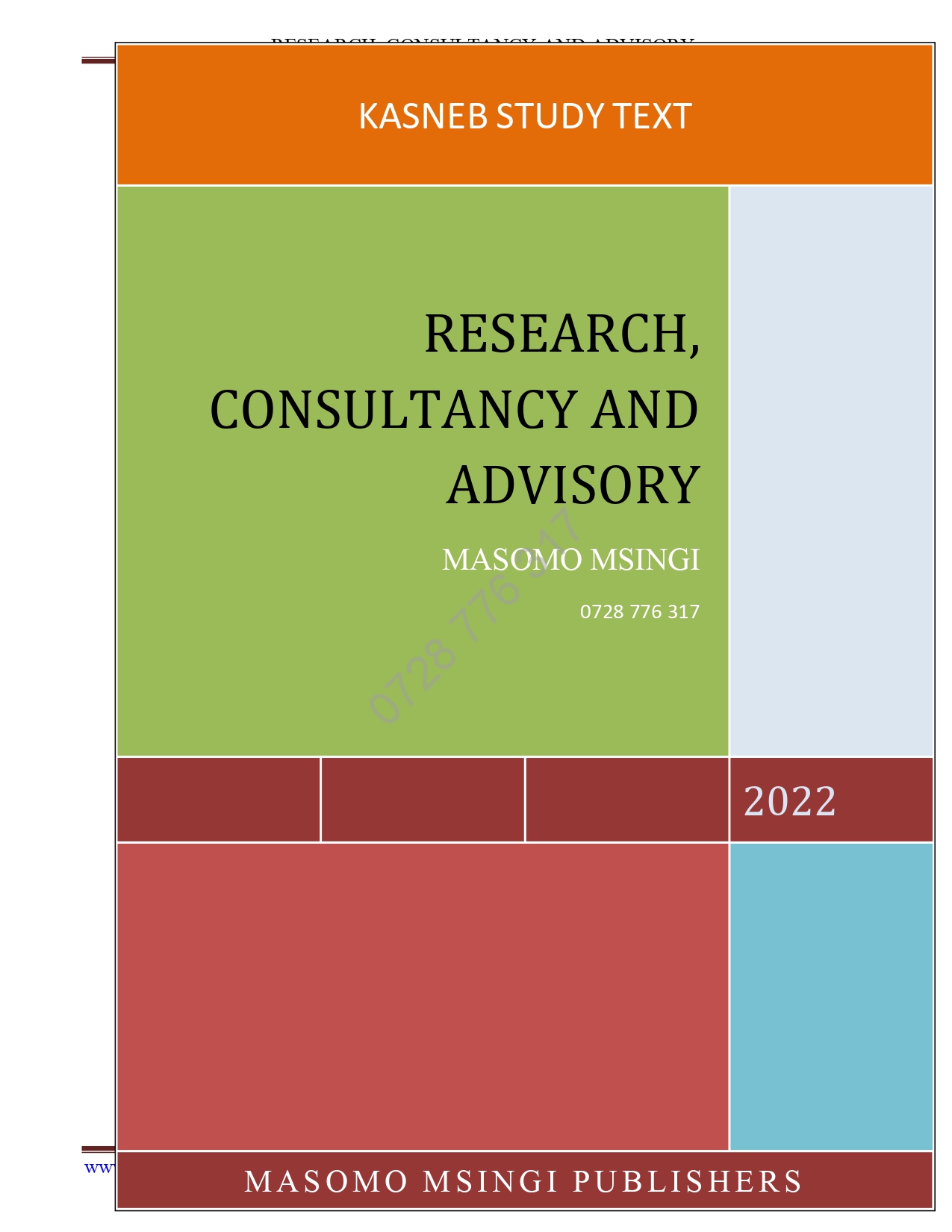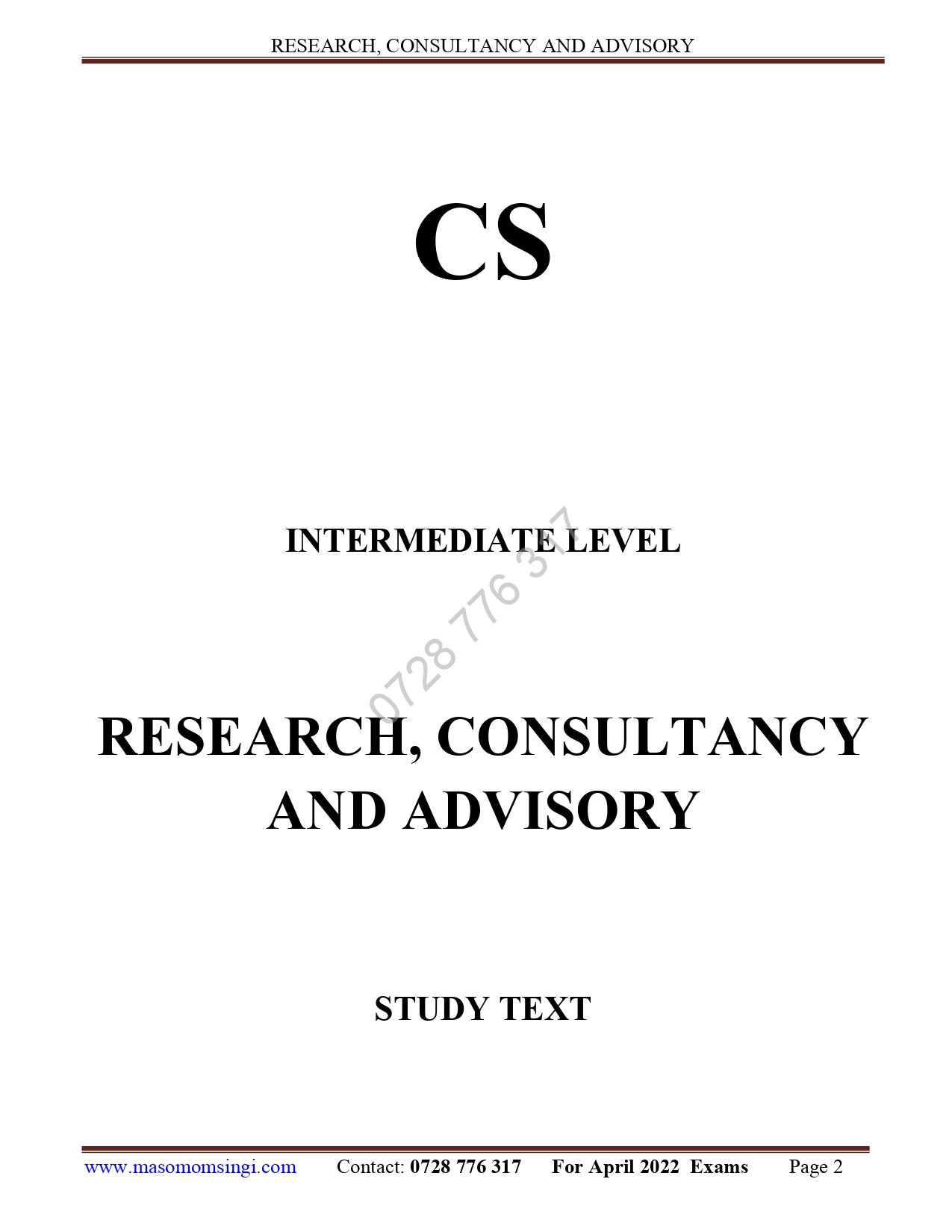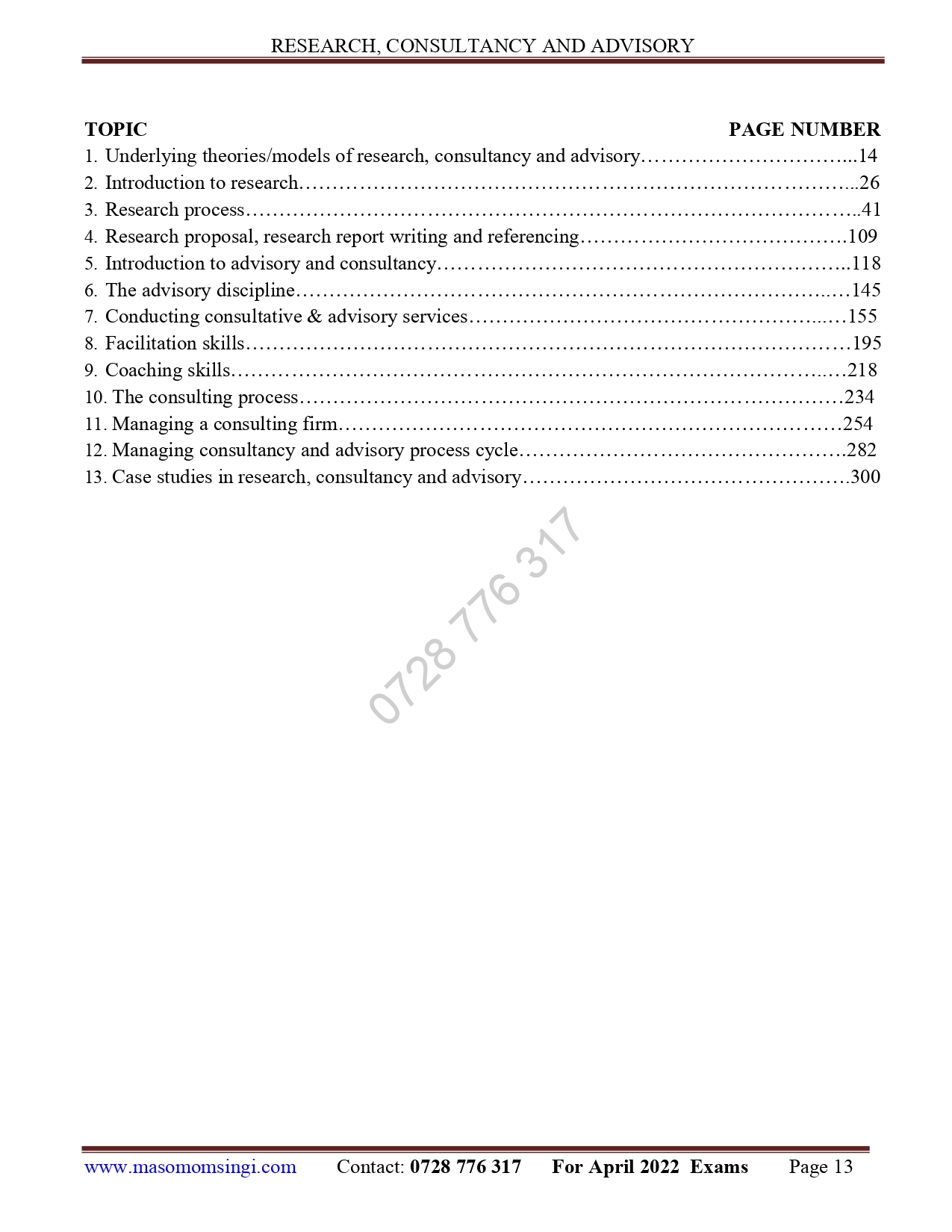MASOMO MSINGI PUBLISHERS APP – Click to download and access all our materials in PDF


MASOMO MSINGI PUBLISHERS APP – Click to download and access all our materials in PDF
INTRODUCTION
Following our continued effort to provide quality study and revision materials at an affordable price for the private students who study on their own, full time and part time students, we partnered with other team of professionals to make this possible.
PAPER NO. 12 RESEARCH, CONSULTANCY AND ADVISORY UNIT DESCRIPTION
This paper is intended to equip the candidate with the knowledge, skills and attitudes that will enable him/her to design and implement research, translate research findings as well as undertake consultancy and advisory services on matters of governance, compliance and management.
LEARNING OUTCOMES
A candidate who passes this paper should be able to:
- Articulate a clear research question or problem and formulate a hypothesis
- Identify and apply appropriate research approaches and methodologies
- Write a research report and explain their research findings through presentations
- Effective manage and implement management consultancy projects
- Develop project implementation plans
- Demonstrate coaching and facilitation skills and techniques as components of consultancy and advisory services
SAMPLE WORK
Complete copy of CS RESEARCH, CONSULTANCY AND ADVISORY STUDY TEXT is available in SOFT copy (Reading using our MASOMO MSINGI PUBLISHERS APP) and in HARD copy
Phone: 0728 776 317
Email: info@masomomsingi.com
CONTENT
Underlying Theories/Models of Research, Consultancy and Advisory
Selected Research and Consultancy Theories
- Social-systems theory
- Social network theory
- Situated learning theory
- Otherness & Parasites theory
- The Intervention Theory of Argyrols.
- Blake and Mouton’s Consultation Theory
- Weisberg’s Theory of Organisational Diagnosis
- Theory of Planned Behaviour
- Innovation diffusion theory.
- General Deterrence Theory
Introduction to Research
General Overview
- Research Philosophies
- Research Methodologies
- Types of Research
- Research design
- Purpose and importance of research
- Research ethics and integrity
Types of Research
- Historical Research
- Comparative Research
- Descriptive Research
- Correlation Research
- Experimental Research
- Evaluation Research
- Causal research
- Correlational research
- Action Research
- Echogenic Research
- Feminist Research
- Cultural Research
Research Process
Problem Formulation
- Problem identification/conceptualization
- Research Questions
- Hypothesis construction, characteristics of hypothesis, hypothesis testing.
- Statement of Objectives
- Literature Review; citations
- Conceptual framework
Tests of Hypothesis
- Basic Concepts Concerning Testing of Hypotheses
- Procedure for Hypothesis Testing
- Type I Type II Errors
- Test of Significance
Methods of Sampling
- Systematic Sampling
- Distinction between a Systematic Random sample and a Simple Random Sample
- Stratified Sampling
- Strategies involved in Stratified Sampling
- Advantages of Stratified Sampling over other Sampling Methods
- Disadvantages of Stratified Sampling
- Some Non-Random Sampling Method
Data Collection
- Unpublished Sources
- Published Data
- Necessary Guidelines for Collecting Reliable Data
- Methods of Collecting Data
- Stages in the Collection of Data
- Design of a Good Questionnaire
Processing and analysing data
- Steps in Data Analysis
- Methods of data analysis
- Narrative Data Analysis
- Statistical Data Analysis
- Descriptive Data Analysis
- Data Analysis Techniques
- Univariate Distribution
- The Frequency Distribution
- Measures of Central Tendency
- Measures of Dispersion
- Types data analysis and significance tests.
- Use of software
- Interpretation of results
- The cyclic nature of research
Data interpretation and presentation
- Technique of Interpretation
- Precaution in Interpretation
- Frequency tables
- Pie charts
- Graphs
Writing the report.
- Significance of Report Writing
- Different Steps in Writing Report
- Layout of the Research Report
- Types of Reports
- Oral Presentation
- Precautions for Writing Research Report
Research Proposal, Research Report Writing and Referencing
- Basic principles
- Formats, contents, presentation data presentation; use of charts, graphs and tables.
- Referencing styles, citation of primary and secondary sources, foot notes and end notes, bibliography and references
- Format of Certified Secretaries research project
Introduction to Advisory and Consultancy
-
- General Background
- Role of consultants
- Qualities of a good consultant
- Developing internal consulting skills
- The internal consultant’s role
- How the internal consultant differs from line management and external consultancy
- Skills and knowledge requirements
- Time management, managing customer expectations, creative problem solving, communication skills, working with clients, managing politics, managing conflict, managing client-consultant relationships.
- Difference between Consultancy and Advisory
- Uses of consultants – public sector, private sector, and internal consulting
- Consulting roles and culture
- Professionalism and ethics
- Legal and ethical considerations
Nature and Purpose of Management Consulting
- What is consulting?
- Why are consultants used? Five generic purposes
- How are consultants used? Ten principal ways
- The consulting process
- Evolving concepts and scope of management consulting
The Consulting Industry
- A historical perspective
- The current consulting scene
- Range of services provided
- Generalist and specialist services
- Main types of consulting organisation
- Internal consultants
- Management consulting and other professions
The Advisory Discipline
- Role of an Advisor
- What Makes a Good Advisor?
- Strategy, Execution and Accountability
- Crisis Management
- Business Resilience Overview
- Mapping Out the Client Discovery
- Building Trust
- Confidence and Experience
- Business Planning Process
Conducting Consultative & Advisory Services
-
- Basic Consultative Approaches
- Expert Approach
- Medical (Doctor-Patient) Approach
- Process Approach
- Emergent Approach (Emergent Organisational Development And Change (EODC)
- The Client and Consultant Relationship
- Defining roles and expectations
- The client and the consultant systems
- Critical dimensions of the consultant–client relationship
- Negotiation, persuasion and coaching skills
- Professionalism and Ethics in Consulting
- Is management consulting a profession?
- The professional approach
- Professional associations and codes of conduct
- Certification and licensing
- Legal liability and professional responsibility
Facilitation Skills
-
- Introduction to facilitation
- Definition of facilitation
- Purpose of facilitation
- Role and skills of the facilitator
- Differences between facilitation, instruction, training, and chairing
Facilitation process
- Problem/goal identifications
- Problem resolution/decision making
- Implementing solution
- Groups dynamics
- Group decision making
- Guidelines for group consensus building
- Managing behaviours
- Team development
- Facilitations tools and techniques: brainstorming, cluster, voting, process mapping, storyboarding, Ishikawa diagram – fishbone, nominal group technique, de bono, thinking hats, solving performance problems, etc.
- Presentation: opening and closing; audience; purpose (convince, educate, motivate etc.); content; time; tools; style; practionalities – 3 ps (prepare, practice and practice again); preparing PowerPoint presentations
- Handling controversial issues
- Communication skills
- Listening skills-watching both verbal and nonverbal cues
- Providing effective feedback
- Managing divergent perspectives
- Leveraging on ICT in facilitating
Coaching Skills
- Role and skills of an effective coach
- Managing from a coaching perspective
- Handling resistance to constructive criticism
- Using effective probing and questioning
- Workplace coaching techniques
- Key motivational coaching skills
- Limitations of coaching
- Differences between coaching, mentoring, counselling, training, managing, consulting and life coaching
- Essential coaching skills: listening, questioning, reflecting back and mirroring, paraphrasing and summarising
- The grow model and its applicability
- Selecting a coaching style to match the individual situation
- Planning and delivering a structured coaching session
- Measuring the success and impact of the coaching
The Consulting Process
-
- Introduction
- Entry and Contracting
- First client meetings
- Preliminary problem diagnosis
- Terms of reference – Technical proposals and Financial proposals
- Assignment strategy and plan
- Proposal to the client
- The consulting contract
- Types of projects and project cycles
- Proposal development
- Consulting contract
- Service Quality
- Engagement and Implementation
- Management of projects
- Presentations and communicating with clients
- Ongoing client contact and service
- Extension, Recycle, or Termination
- Time for withdrawal
- Final reporting
- Evaluation & validation
- Feedback to the client
Action Planning
- Searching for possible solutions
- Developing and evaluating alternatives
- Presenting action proposals to the client
Implementation
- The consultant’s role in implementation monitoring implementation
- Training and developing client staff
- Some tactical guidelines for introducing changes in work methods
- Maintenance and control of the new practice
Termination
- Time for withdrawal
- Evaluation
- Follow-up
- Final reporting
Managing a Consulting Firm
- Fundamentals of management in the consulting profession
- The management challenge of the professions
- Managing a professional service
- Managing a professional business
- Achieving excellence professionally and in business
The Consulting Firm’s Strategy
- The strategic approach
- The scope of client services
- The client base
- Growth and expansion
- Going international
- Profile and image of the firm
- Strategic management in practice
Legal and Ethical Issues
- Legal risks and management
- Client privilege issues
- Professional ethics
- Client’s Perspective
- Selection of consultants
- Effective management of consultants
- Evaluation of performance
- Use of consultants
- Maintaining independence and objectivity
Marketing Professional Services
- Features of services: Intangibility; Inseparability; Heterogeneity (or variability); Perishability.
- Challenges in marketing services
- Marketing techniques for professional services
- Specialization and niche targeting
- Blogs and articles
- A lead-generating website
- Search engine optimization (SEO)
- Speaking engagements
- Trade show participation
- Social media
- Online video
- Other techniques
- Direct and indirect channels of distribution
- Legal, professional and ethical considerations. – ICS guideline on professional ethics and conduct
Pricing Professional Services
- Factors that determine pricing: cost, client value, competition, one off or retainer, pricing guidelines by professional body
- Pricing strategies
- A value-based pricing strategy
- Time and materials pricing
- Market pricing,
- Package pricing/ fixed pricing
Managing Consultancy and Advisory Process Cycle
- Obtaining the assignment
- Terms of reference for consultancy assignments
- Technical and financial consultancy proposals
- Preparation for consultancy assignments
- Understanding clients’ needs
- Determining the scope of assignment
- Client readiness and consultant’s capability
- Gathering key information
- Developing an action plan
- Recording progress and client feedback
- Report writing
- Step-by-step approach of the advisory process
- Implementation of your advice/change
- checking for consistency, understanding your clients, and proposals,
- Monitor and evaluate consultancy assignments
- Legal and ethical issues in the management of consultancy assignments
Case studies in research, consultancy and advisory
SAMPLE WORK
Complete copy of CS RESEARCH, CONSULTANCY AND ADVISORY STUDY TEXT is available in SOFT copy (Reading using our MASOMO MSINGI PUBLISHERS APP) and in HARD copy
Phone: 0728 776 317
Email: info@masomomsingi.com

CHAPTER 1
UNDERLYING THEORIES/MODELS OF RESEARCH, CONSULTANCY AND ADVISORY
Selected Research and Consultancy Theories
Social-systems theory
Social work practice approaches are highly influenced by theory. The theory is something that helps us explain and predict human behavior. In social work practice, social systems theories shape many courses and programs. Social systems theory helps us understand that a person is a product of their social environment at multiple levels of that environment.
Systems theory, also called social systems theory, in social science, the study of society as a complex arrangement of elements, including individuals and their beliefs, as they relate to a whole (e.g., a country). The study of society as a social system has a long history in the social sciences. The conceptual origins of the approach are generally traced to the 19th century, particularly in the work of English sociologist and philosopher Herbert Spencer and French social scientist Émile Durkheim.
An important aspect of social differentiation is the way in which adaptation occurs, or how changes in the structure of the system relate to the processes of the system. On one hand, society can be viewed as a total organism that is sustained by the various processes that support its function and survival. An alternative view argues that stabilizations in social systems occur not because of any rational plan of overall survival but simply because they happen to work.
Systems theory is also involved in analyzing how society adapts to its environment through adjustments in its structure, with important implications for the understanding of social order. Systems theory reveals the complexity of social evolution and, on this basis, stresses the limited possibility of steering society. On the other hand, because society is vastly complex, the social scientist can nonetheless have an appreciation of the large range of adaptive possibilities for social systems.
- System: An entity that’s made up of interrelated/interdependent parts.
- Complex system: The greater, whole system made up of individual, smaller systems. Generally used in social sciences.
- Ecological systems: The various systems in an individual’s life that influence their behavior.
- Homeostasis: The state of steady conditions within a system. A system is always moving toward homeostasis.
Some of the concepts of systems theory as they apply to psychology, sociology and social work:
- Adaptation: A system’s tendency to make changes that will protect itself when presented with new environmental factors.
- Feedback loop: When the outputs of a system ultimately affect its inputs, causing the system to feed back into itself circularly.
Social network theory
Social Network Theory is the study of how people, organizations or groups interact with others inside their network. Understanding the theory is easier when you examine the individual pieces starting with the largest element, which is networks, and working down to the smallest element, which is the actors.
Examining Networks
In some ways, networks can be thought of as neighborhoods, since networks are comprised of the actors and the relationships between those actors. These actors, referred to as nodes, can be individuals, organizations or companies. Regardless of what they are, they are always the smallest single unit inside a network. If you view the United Nations as a social network, the United States would be a node or actor inside the network.
The three types of social networks that social scientists explore are ego-centric networks, socio- centric networks, and open-system networks.
- Ego-centric networks are connected with a single node or individual. For example, you, the node, connected to all your close friends.
- Socio-centric networks are closed networks by default. Two commonly-used examples of this type of network are children in a classroom or workers inside an organization.
- In open-system networks, the boundary lines are not clearly defined. A few examples in this type of network are America’s elite class, connections between corporations, or the chain of influencers of a particular decision. Due to the lack of clearly-defined boundaries, this type of network is considered the most difficult to study.
Six Degrees of Separation
One of the most fascinating aspects of Social Network Theory is the six degrees of
separation concept. This concept was the outcome of a late 1960s social experiment called The Small World Problem, conducted by Stanley Milgram, in which 100 letters were sent to randomly chosen individuals with a set of instructions to get the letter to a specific individual who lived in Sharon, Massachusetts. However, a couple of stipulations determined how the letter could reach the Sharon, MA target.
- First, recipients of the letter could only send the letter to someone they knew firsthand, but that person should be someone they thought may know someone who knew the target.
- Second, if the recipient knew the target, they were to directly mail the letter to the target.
Strengths and Weaknesses of the Theory
Due to the complexity of any social network, using the theory to understand actors and the relationships between them is crucial to the work of social scientists, theorists, politicians, and even marketers. These researchers often try to glean a better understanding of the inner workings of a network so they can further their cause or simply sell a product. The theory, though, does have some inherent strengths and weaknesses.
Strengths:
- The theory offers an explanation for how random people are connected.
- It’s useful in the study of large groups and understanding how their members relate to others in the group
- It provides insight into viral phenomena, such as viral content, the spread of diseases like ebola, etc.
Weaknesses:
- It’s difficult to scientifically replicate.
- Interpreting relationships/ties can be subjective.
Situated learning theory
Situated learning, also known as situated cognition, first emerged as an instructional model through the research of Paul Duguid, John Seely Brown, and Allan Collins. Their paper,
titled “Situated Cognition and the Culture of Learning” criticized the division of knowledge and practice. Situated learning is based on ideas from many fields, such as psychology, sociology, cognitive science, and anthropology. Duguid, Brown, and Collins disagreed with public schools and how they treated knowledge “as an integral, self-sufficient substance, theoretically independent of the situations in which it is learned and used.”
